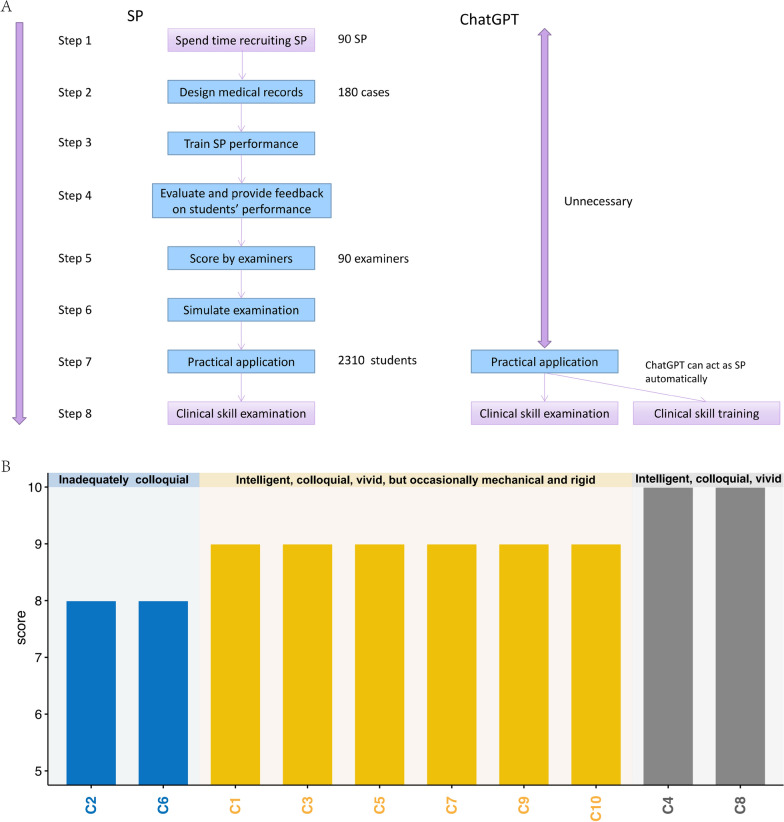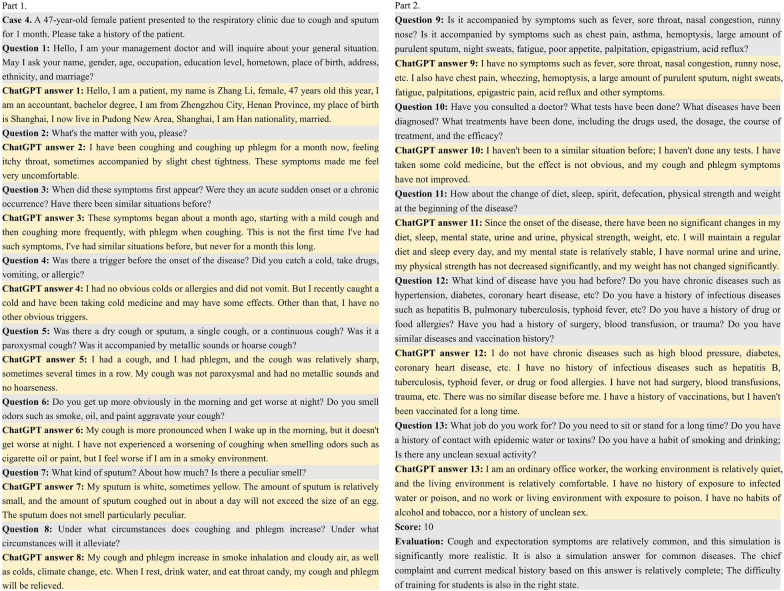Letter to the editor:
Standardized patients (SP) were an effective and important program to help medical students develop communication skills [1]. Compared with the low-fidelity manikin, the SP group had significantly higher test scores and communication skills [2]. Artificial intelligence (AI) helps guide medical decisions that benefit individuals and populations and provides insights for optimizing various systems such as public health [3]. Since the release of the chat robot ChatGPT, this artificial intelligence technology has clearly had a significant impact on the way humans work [4]. Due to the importance of SP in clinical training and education, we collected 10 patient histories related to clinical training and education using ChatGPT, and evaluated them by senior physicians to verify the accuracy of the information generated by ChatGPT simulating SP.
We provided 10 cases (11 to 15 questions for each case) to ChatGPT (ChatGPT-3.5-turbo, mode) and collected the medical histories of these 10 patients through ChatGPT simulating SP. Based on the answers provided by ChatGPT to each question, then we asked 5 senior physicians to evaluate their accuracy. Senior physicians independently evaluated the accuracy score (0–10 points) of each case and summarized them together.
We used the standardized training exam for resident doctors in Jiangxi Province as an example, and drew the flowchart of SP and ChatGPT simulating SP training respectively (Fig. 1A). Compared with real SP, ChatGPT simulating SP could eliminate the need for complex steps 1–6, meaning that ChatGPT simulating SP did not need to prepare medical records or additional training and could be used directly, saving a lot of time, manpower and resources. After evaluation of 5 senior physicians, out of 10 cases, 2 were rated as 10 points and 6 were rated as 9 points, the remaining 2 cases were rated as 8 points (Fig. 1B). ChatGPT simulating SP played a good role in all stages of consultation. For example, case 4 had 13 questions and an evaluation score of 10 (Fig. 2). Firstly, ChatGPT simulating SP was highly intelligent. When ChatGPT met different cases, it could quickly combine the patient's chief complaints and give appropriate and correct answers. Secondly, ChatGPT simulating SP responses were colloquial. When ChatGPT was responding to a doctor’s query, it answered the questions in a tone close to that of the patient, such as in questions 2 and 6. Thirdly, ChatGPT simulating SP’s responses were vivid and accurate. When ChatGPT described symptoms, it would use vivid words and answer accurately, as demonstrated in question 7. However, ChatGPT simulating SP’s responses were mechanical and rigid occasionally when we asked more than one question at a time, such as in cases 9 and 12. The descriptions of symptoms reached the level of our clinical skills training and SP simulation in the test station. In general, ChatGPT can simulate the complete medical record interrogation mode without disconnection and can be applied to the SP interrogation mode.
Fig. 1.
A. Flow chart of SP and ChatGPT simulating SP training. B. Evaluation scores and characteristics of 10 cases
Fig. 2.
ChatGPT communicated with physicians as SP, and its responses were evaluated by senior physicians. Gray represents the questions we asked, and light yellow indicates the answers responded by ChatGPT
In the past few years, ChatGPT has already impacted and made progress in many fields, such as healthcare and education [5]. Nevertheless, ChatGPT has not been reported on simulating SP. In our study, ChatGPT had several advantages in simulating SP. ChatGPT simulating SP was able to combine themes and responded intelligently, colloquially, vividly and accurately, enabling it to play various patient roles. However, there were also some drawbacks, such as ChatGPT simulation of SP's responses being mechanical and rigid occasionally.
Therefore, our results showed that ChatGPT simulating SP could assist in clinical training and education, thereby more effectively guiding doctors' clinical skills, optimizing the education system, and improving medical skills. Meanwhile, it could alleviate the problem of human resource shortage when training real SP. Of course, the problems and limitations of ChatGPT simulating SP required us to maintain criticism, continuously improve and optimize during the use process.
In the future, we look forward to ChatGPT being applied as an SP in our medical education and training. Of course, to ensure the optimal integration of artificial intelligence-based learning tools in medical education, further research and evaluation are still needed.
Acknowledgements
Not applicable.
Abbreviation
- SP
Standardized patients
Author contributions
WLZ conceived the project. XNL, CLW, HL, YYX analyzed the results, YSL and RL contributed to the interpretation of the data. WLZ and CLW revised the article. All authors read and agreed to the final manuscript.
Funding
This work was funded by National Natural Science Foundation of China (81800195), Key Clinical Projects of Peking University Third Hospital (BYSYZD2019026, BYSYDL2021006).
Availability of data and materials
Not applicable.
Declarations
Ethics approval and consent to participate
Not applicable.
Consent for publication
Not applicable.
Competing interests
The authors declared no competing interests.
Footnotes
Publisher's Note
Springer Nature remains neutral with regard to jurisdictional claims in published maps and institutional affiliations.
Xiaoni Liu and Chaoling Wu have contributed equally to this work.
Contributor Information
Yuansheng Lin, Email: linys202012@163.com.
Weilong Zhang, Email: zhangwl2012@126.com.
References
- 1.Kucukkelepce GE, Dinc L, Elcin M. Effects of using standardized patients on nursing students' moral skills. Nurs Ethics. 2020;27(7):1587–1602. doi: 10.1177/0969733020935954. [DOI] [PubMed] [Google Scholar]
- 2.Altun S, Tastan S. Low-fidelity simulation vs. standardized patients in prevention and management of pressure injury education. J Tissue Viability. 2022;31(4):643–8. doi: 10.1016/j.jtv.2022.07.016. [DOI] [PubMed] [Google Scholar]
- 3.Dorr DA, Adams L, Embí P. Harnessing the promise of artificial intelligence responsibly. JAMA. 2023;329(16):1347–1348. doi: 10.1001/jama.2023.2771. [DOI] [PubMed] [Google Scholar]
- 4.van Dis EAM, Bollen J, Zuidema W, van Rooij R, Bockting CL. ChatGPT: five priorities for research. Nature. 2023;614(7947):224–226. doi: 10.1038/d41586-023-00288-7. [DOI] [PubMed] [Google Scholar]
- 5.Preiksaitis C, Sinsky CA, Rose C. ChatGPT is not the solution to physicians’ documentation burden. Nat Med. 2023;29(6):1296–1297. doi: 10.1038/s41591-023-02341-4. [DOI] [PubMed] [Google Scholar]
Associated Data
This section collects any data citations, data availability statements, or supplementary materials included in this article.
Data Availability Statement
Not applicable.




